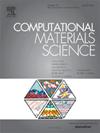基于OPLS-AA力场参数优化的真实石蜡熔点分子动力学模拟
IF 3.3
3区 材料科学
Q2 MATERIALS SCIENCE, MULTIDISCIPLINARY
引用次数: 0
摘要
原油有机固相析出机理的分子动力学研究对保障油气生产具有重要的指导意义。为了解决现有力场在模拟原油中蜡相关性质时存在的显著不准确性问题,本研究将量子化学方法与实验数据相结合,对力场进行了优化。基于OPLS-AA力场框架,我们采用量子化学M06-2X/def2-TZVP方法对直链烷烃的二面角进行了松弛扫描,得到了所有的二面角扭转参数。利用C22、C26和C30正构烷烃的熔点对电荷参数进行了优化,建立了改进的p - ops力场。验证结果表明,该力场能较准确地计算正构烷烃的蒸发焓和粘度。通过对油田实际原油中真实石蜡的熔点进行模拟,结果表明:A-1井和A-2井用P-OPLS力场模拟的石蜡熔点与实验熔点的相对误差分别为0.56%和0.42%。这进一步证实了p - ops力场在模拟混合组分烷烃体系中的准确性。此外,取向顺序参数和分子链的可视化表明,蜡分子在结晶过程中呈线性排列。链长相似的石蜡分子在形成晶体时更容易相互匹配和排列,这有助于形成稳定的结构。该研究为模拟和研究直链烷烃体系提供了可靠的p - ops力场,为进一步研究原油中蜡沉淀机理提供了潜在的基础。本文章由计算机程序翻译,如有差异,请以英文原文为准。

Molecular dynamics simulation of real paraffin wax melting points based on OPLS-AA force field parameter optimization
The molecular dynamics study on the mechanism of organic solid phase precipitation in crude oil has important guiding significance for ensuring oil and gas production. To address the notable inaccuracies of existing force fields in simulating wax-related properties in crude oil, this study optimizes the force field by integrating quantum chemistry methods with experimental data. Based on the OPLS-AA force field framework, we employed the quantum chemical M06-2X/def2-TZVP method to perform relaxed scanning of dihedral angles in straight-chain alkanes, obtaining all dihedral torsional parameters. The charge parameters were optimized using the measured melting points of C22, C26, and C30 n-alkanes, leading to the development of an improved P-OPLS force field. Validation results demonstrate that this force field provides the most accurate calculations for the evaporation enthalpy and viscosity of n-alkanes. By simulating the melting points of real paraffin wax in actual crude oil from oilfields, the results show that the relative errors between the simulated melting points of paraffin wax in Well A-1 and Well A-2 using the P-OPLS force field and the experimental melting points are 0.56 % and 0.42 %, respectively. This further confirms the accuracy of the P-OPLS force field in simulating mixed-component alkane systems. Additionally, the visualization of orientation order parameters and molecular chains indicates that wax molecules are arranged in a linear order during the crystallization process. Paraffin molecules with similar chain lengths are more likely to match and align with each other when forming crystals, which helps to form stable structures. This study provides a reliable P-OPLS force field for simulating and studying straight chain alkane systems, and provides a potential basis for further investigating the mechanism of wax precipitation in crude oil.
求助全文
通过发布文献求助,成功后即可免费获取论文全文。
去求助
来源期刊

Computational Materials Science
工程技术-材料科学:综合
CiteScore
6.50
自引率
6.10%
发文量
665
审稿时长
26 days
期刊介绍:
The goal of Computational Materials Science is to report on results that provide new or unique insights into, or significantly expand our understanding of, the properties of materials or phenomena associated with their design, synthesis, processing, characterization, and utilization. To be relevant to the journal, the results should be applied or applicable to specific material systems that are discussed within the submission.
 求助内容:
求助内容: 应助结果提醒方式:
应助结果提醒方式:


